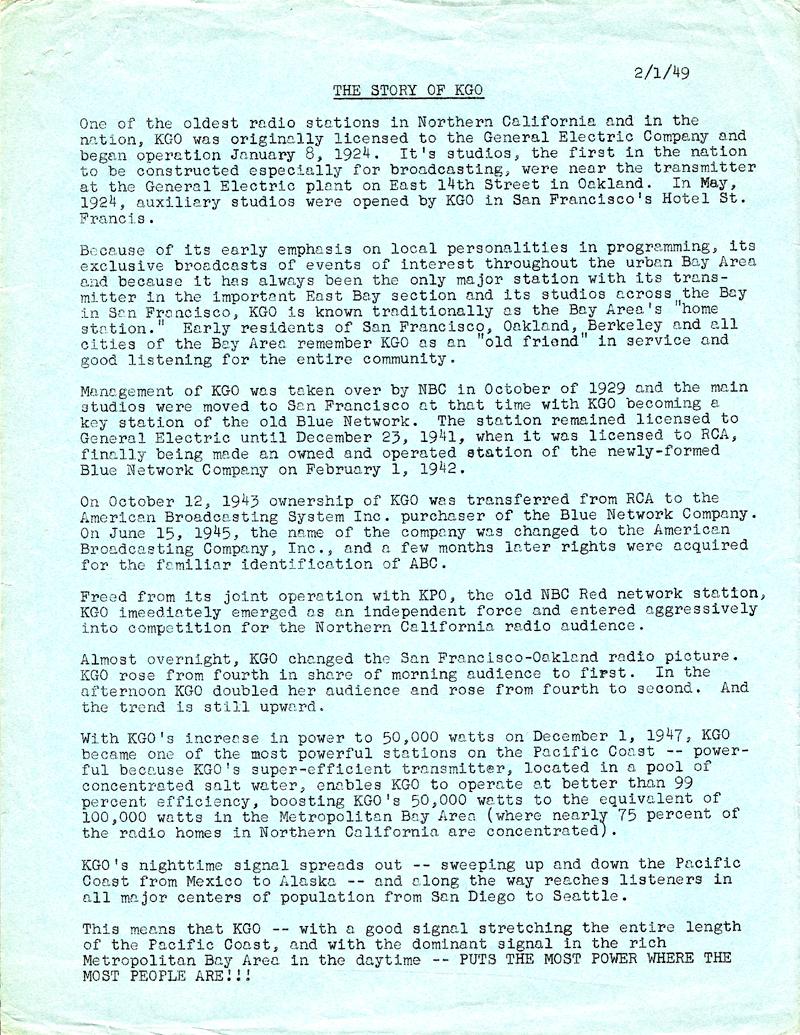KGO Radio
San Francisco
The Story Of KGO
February 1, 1949


This brief typewritten biography of KGO Radio in San Francisco accompanied a copy of the station’s 1950 sales brochure (inset right). A simplified overview of the historic station, which began its life at the General Electric plant in East Oakland, it tells a tale of redemption as KGO breaks free from its twin, KPO, and its owner, the National Broadcasting Company, to achieve success “almost overnight” on its own.
General Electric had leased the KGO to NBC — which was owned, in part, by G.E. — beginning on October 1, 1929, mere weeks before the stock market crash that launched the Great Depression. Under the lease, KGO’s studios were moved from Oakland to the Hunter-Dulin Building at 111 Sutter Street in San Francisco (joining KPO there), with KGO becoming a key station on NBC’s Blue Network.
NBC’s lease on KGO expired in 1941, but on January 9, 1942, the station was sold to NBC, which transferred KGO’s license to the subsidiary Blue Network Company. The Blue Network — along with KGO — was sold in 1943, with the network renamed as the American Broadcasting Company.
Noted in the text is an increase in power to 50,000 watts in 1947, which included a move to a new transmitter plant along the salt ponds near the Dumbarton Bridge approach on the eastern side of the Bay. KGO had begun its life in 1924 with 1,000 watts, which was increased incrementally over the first few years of the station’s existence until it reached 7,500 watts in 1928. (KGO briefly operated with 12,500 watts in the Spring of 1927.)
The text of the document is transcribed below:
2/1/49
THE STORY OF KGO
One of the oldest radio stations in Northern California and in the nation, KGO was originally licensed to the General Electric Company and began operation January 8, 1924. Its studios, the first in the nation to be constructed especially for broadcasting, were near the transmitter at the General Electric plant on East 14th Street in Oakland. In May 1924, auxiliary studios were opened by KGO in San Francisco’s Hotel St. Francis.
Because of its early emphasis on local personalities in programming, its exclusive broadcasts of events of interest throughout the urban Bay Area and because it has always been the only major station with its transmitter in the important East Bay section and its studios across the Bay in San Francisco, KGO is known traditionally as the Bay Area’s “home station.” Early residents of San Francisco, Oakland, Berkeley and all cities of the Bay Area remember KGO as an “old friend” in service and good listening for the entire community.
Management of KGO was taken over by NBC in October of 1929 and the main studios were moved to San Francisco at that time with KGO becoming a key station of the old Blue Network. The station remained licensed to General Electric until December 23, 1941, when it was licensed to RCA, finally being made an owned and operated station of the newly-formed Blue Network Company on February 1, 1942.
On October 12, 1943 ownership of KGO was transferred from RCA to the American Broadcasting System Inc., purchaser of the Blue Network Company. On June 15, 1945, the name of the company was changed to the American Broadcasting Company, Inc., and a few months later rights were acquired for the familiar identification of ABC.
Freed from its joint operation with KPO, the old NBC Red network station, KGO immediately emerged as an independent force and entered aggressively into competition for the Northern California radio audience.
Almost overnight, KGO changed the San Francisco-Oakland radio picture. KGO rose from fourth in share of morning audience to first. In the afternoon, KGO doubled her audience and rose from fourth to second. And the trend is still upward.
With KGO’s increase in power to 50,000 watts on December 1, 1947, KGO became one of the most powerful stations on the Pacific Coast — powerful because KGO’s super-efficient transmitter, located in a pool of concentrated salt water, enables KGO to operate at better than 99 percent efficiency, boosting KGO’s 50,000 watts to the equivalent of 100,000 watts in the Metropolitan Bay Area (where nearly 75 percent of the radio homes in Northern California are concentrated).
KGO’s nighttime signal spreads out — sweeping up and down the Pacific Coast from Mexico to Alaska — and along the way reaches listeners in all major centers of population from San Diego to Seattle.
This means that KGO — with a good signal stretching the entire length of the Pacific Coast, and with the dominant signal in the rich Metropolitan Bay Area in the daytime — PUTS THE MOST POWER WHERE THE MOST PEOPLE ARE!!!
SOURCE: Bay Area Radio Museum Collection.
RELATED EXHIBITS:
![]()

I loved KGO…KABC also…but the fact is AM is hurting…outlets selling for millions just twenty years ago are sold at fire sale price…it’s the publics choice, not wanting to be ‘bothered’ from their world, real information lost…and in recent times reality lost also…five decades tuning in KGO, I shall miss all from the late Dr Bill, even Ray Taliferro…it WAS an amazing station !